An energy-efficient object detection system for UAVs based on edge computing
Morphobots for Mars: Caltech Develops All-Terrain Robot as Candidate for NASA Mission
MIT engineers use kirigami to make ultrastrong, lightweight structures
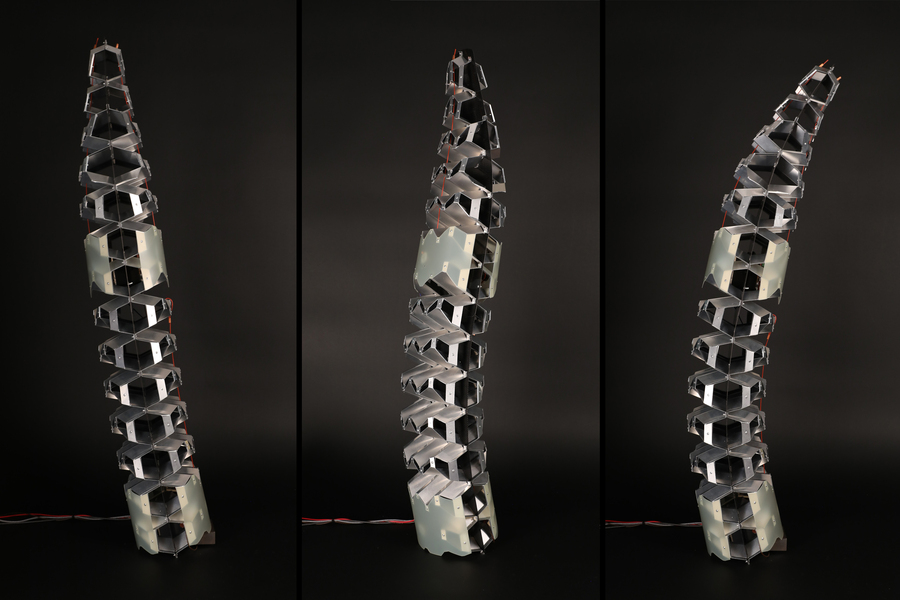
MIT researchers used kirigami, the art of Japanese paper cutting and folding, to develop ultrastrong, lightweight materials that have tunable mechanical properties, like stiffness and flexibility. These materials could be used in airplanes, automobiles, or spacecraft. Image: Courtesy of the researchers
By Adam Zewe | MIT News
Cellular solids are materials composed of many cells that have been packed together, such as a honeycomb. The shape of those cells largely determines the material’s mechanical properties, including its stiffness or strength. Bones, for instance, are filled with a natural material that enables them to be lightweight, but stiff and strong.
Inspired by bones and other cellular solids found in nature, humans have used the same concept to develop architected materials. By changing the geometry of the unit cells that make up these materials, researchers can customize the material’s mechanical, thermal, or acoustic properties. Architected materials are used in many applications, from shock-absorbing packing foam to heat-regulating radiators.
Using kirigami, the ancient Japanese art of folding and cutting paper, MIT researchers have now manufactured a type of high-performance architected material known as a plate lattice, on a much larger scale than scientists have previously been able to achieve by additive fabrication. This technique allows them to create these structures from metal or other materials with custom shapes and specifically tailored mechanical properties.
“This material is like steel cork. It is lighter than cork, but with high strength and high stiffness,” says Professor Neil Gershenfeld, who leads the Center for Bits and Atoms (CBA) at MIT and is senior author of a new paper on this approach.
The researchers developed a modular construction process in which many smaller components are formed, folded, and assembled into 3D shapes. Using this method, they fabricated ultralight and ultrastrong structures and robots that, under a specified load, can morph and hold their shape.
Because these structures are lightweight but strong, stiff, and relatively easy to mass-produce at larger scales, they could be especially useful in architectural, airplane, automotive, or aerospace components.
Joining Gershenfeld on the paper are co-lead authors Alfonso Parra Rubio, a research assistant in the CBA, and Klara Mundilova, an MIT electrical engineering and computer science graduate student; along with David Preiss, a graduate student in the CBA; and Erik D. Demaine, an MIT professor of computer science. The research will be presented at ASME’s Computers and Information in Engineering Conference.
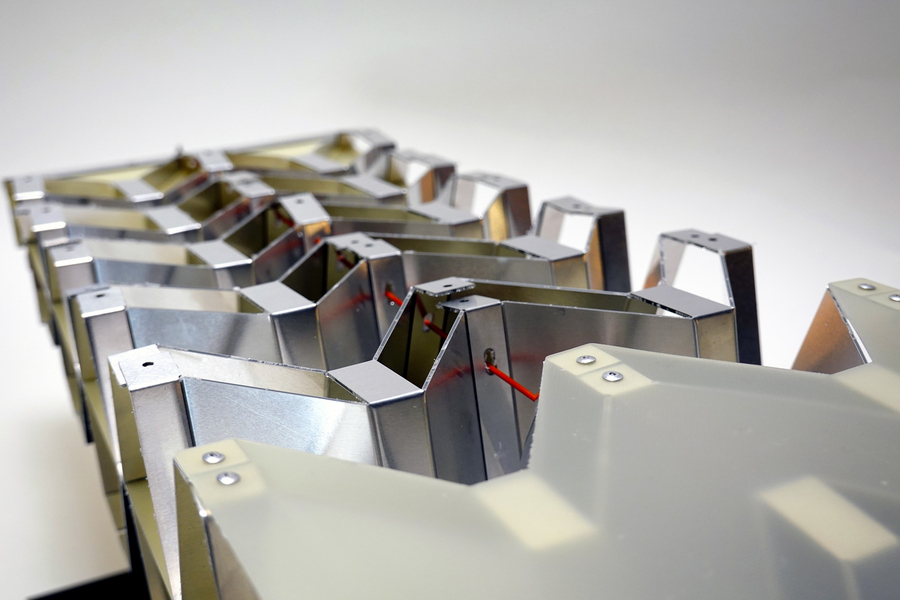
The researchers actuate a corrugated structure by tensioning steel wires across the compliant surfaces and then connecting them to a system of pulleys and motors, enabling the structure to bend in either direction. Image: Courtesy of the researchers
Fabricating by folding
Architected materials, like lattices, are often used as cores for a type of composite material known as a sandwich structure. To envision a sandwich structure, think of an airplane wing, where a series of intersecting, diagonal beams form a lattice core that is sandwiched between a top and bottom panel. This truss lattice has high stiffness and strength, yet is very lightweight.
Plate lattices are cellular structures made from three-dimensional intersections of plates, rather than beams. These high-performance structures are even stronger and stiffer than truss lattices, but their complex shape makes them challenging to fabricate using common techniques like 3D printing, especially for large-scale engineering applications.
The MIT researchers overcame these manufacturing challenges using kirigami, a technique for making 3D shapes by folding and cutting paper that traces its history to Japanese artists in the 7th century.
Kirigami has been used to produce plate lattices from partially folded zigzag creases. But to make a sandwich structure, one must attach flat plates to the top and bottom of this corrugated core onto the narrow points formed by the zigzag creases. This often requires strong adhesives or welding techniques that can make assembly slow, costly, and challenging to scale.
The MIT researchers modified a common origami crease pattern, known as a Miura-ori pattern, so the sharp points of the corrugated structure are transformed into facets. The facets, like those on a diamond, provide flat surfaces to which the plates can be attached more easily, with bolts or rivets.
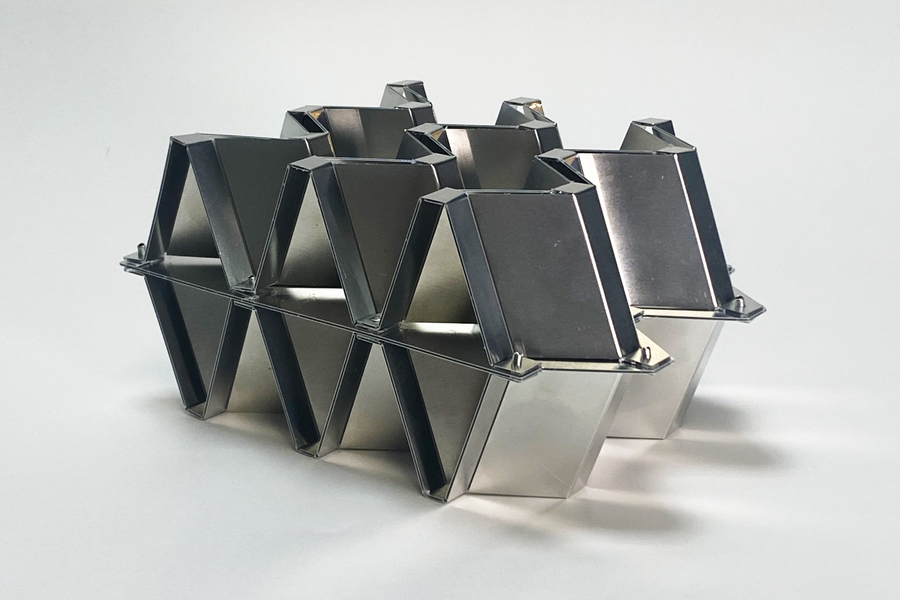
The MIT researchers modified a common origami crease pattern, known as a Miura-ori pattern, so the sharp points of the corrugated structure are transformed into facets. The facets, like those on a diamond, provide flat surfaces to which the plates can be attached more easily, with bolts or rivets. Image: Courtesy of the researchers
“Plate lattices outperform beam lattices in strength and stiffness while maintaining the same weight and internal structure,” says Parra Rubio. “Reaching the H-S upper bound for theoretical stiffness and strength has been demonstrated through nanoscale production using two-photon lithography. Plate lattices construction has been so difficult that there has been little research on the macro scale. We think folding is a path to easier utilization of this type of plate structure made from metals.”
Customizable properties
Moreover, the way the researchers design, fold, and cut the pattern enables them to tune certain mechanical properties, such as stiffness, strength, and flexural modulus (the tendency of a material to resist bending). They encode this information, as well as the 3D shape, into a creasing map that is used to create these kirigami corrugations.
For instance, based on the way the folds are designed, some cells can be shaped so they hold their shape when compressed while others can be modified so they bend. In this way, the researchers can precisely control how different areas of the structure will deform when compressed.
Because the flexibility of the structure can be controlled, these corrugations could be used in robots or other dynamic applications with parts that move, twist, and bend.
To craft larger structures like robots, the researchers introduced a modular assembly process. They mass produce smaller crease patterns and assemble them into ultralight and ultrastrong 3D structures. Smaller structures have fewer creases, which simplifies the manufacturing process.
Using the adapted Miura-ori pattern, the researchers create a crease pattern that will yield their desired shape and structural properties. Then they utilize a unique machine — a Zund cutting table — to score a flat, metal panel that they fold into the 3D shape.
“To make things like cars and airplanes, a huge investment goes into tooling. This manufacturing process is without tooling, like 3D printing. But unlike 3D printing, our process can set the limit for record material properties,” Gershenfeld says.
Using their method, they produced aluminum structures with a compression strength of more than 62 kilonewtons, but a weight of only 90 kilograms per square meter. (Cork weighs about 100 kilograms per square meter.) Their structures were so strong they could withstand three times as much force as a typical aluminum corrugation.
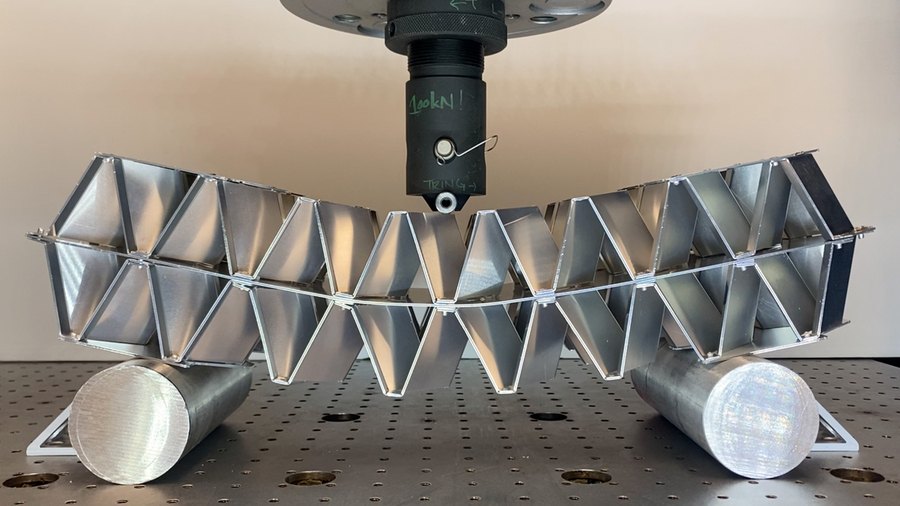
Using their method, researchers produced aluminum structures with a compression strength of more than 62 kilonewtons, but a weight of only 90 kilograms per square meter. Image: Courtesy of the researchers
The versatile technique could be used for many materials, such as steel and composites, making it well-suited for the production lightweight, shock-absorbing components for airplanes, automobiles, or spacecraft.
However, the researchers found that their method can be difficult to model. So, in the future, they plan to develop user-friendly CAD design tools for these kirigami plate lattice structures. In addition, they want to explore methods to reduce the computational costs of simulating a design that yields desired properties.
“Kirigami corrugations holds exciting potential for architectural construction,” says James Coleman MArch ’14, SM ’14, co-founder of the design for fabrication and installation firm SumPoint, and former vice president for innovation and R&D at Zahner, who was not involved with this work. “In my experience producing complex architectural projects, current methods for constructing large-scale curved and doubly curved elements are material intensive and wasteful, and thus deemed impractical for most projects. While the authors’ technology offers novel solutions to the aerospace and automotive industries, I believe their cell-based method can also significantly impact the built environment. The ability to fabricate various plate lattice geometries with specific properties could enable higher performing and more expressive buildings with less material. Goodbye heavy steel and concrete structures, hello lightweight lattices!”
Parra Rubio, Mundilova and other MIT graduate students also used this technique to create three large-scale, folded artworks from aluminum composite that are on display at the MIT Media Lab. Despite the fact that each artwork is several meters in length, the structures only took a few hours to fabricate.
“At the end of the day, the artistic piece is only possible because of the math and engineering contributions we are showing in our papers. But we don’t want to ignore the aesthetic power of our work,” Parra Rubio says.
This work was funded, in part, by the Center for Bits and Atoms Research Consortia, an AAUW International Fellowship, and a GWI Fay Weber Grant.
New AI technology gives robot recognition skills a big lift
PACK EXPO 2023 Product Preview
US military plans to unleash thousands of autonomous war robots over next two years
Tiny, shape-shifting robot can squish itself into tight spaces
Challenge accepted: High-speed AI drone overtakes world-champion drone racers
Faulhaber – New building with diverse production possibilities
A soft glove based on honeycomb pneumatic actuators for assistive care and rehabilitation
Robotic-assisted dressing system accommodates different poses, body types and garments
Talking PACK Expo with Brenton Engineering
Soft robots self-destruct with little trace
New dual-arm robot achieves bimanual tasks by learning from simulation
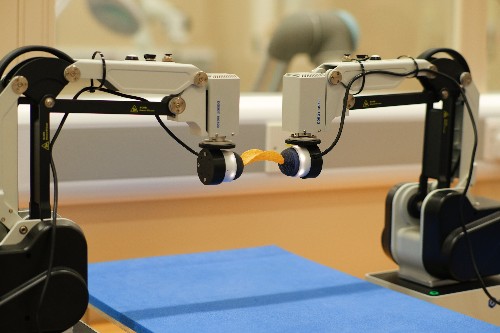
Dual arm robot holding crisp. Image: Yijiong Lin
The new Bi-Touch system, designed by scientists at the University of Bristol and based at the Bristol Robotics Laboratory, allows robots to carry out manual tasks by sensing what to do from a digital helper.
The findings, published in IEEE Robotics and Automation Letters, show how an AI agent interprets its environment through tactile and proprioceptive feedback, and then control the robots’ behaviours, enabling precise sensing, gentle interaction, and effective object manipulation to accomplish robotic tasks.
This development could revolutionise industries such as fruit picking, domestic service, and eventually recreate touch in artificial limbs.
Lead author Yijiong Lin from the Faculty of Engineering, explained: “With our Bi-Touch system, we can easily train AI agents in a virtual world within a couple of hours to achieve bimanual tasks that are tailored towards the touch. And more importantly, we can directly apply these agents from the virtual world to the real world without further training.
“The tactile bimanual agent can solve tasks even under unexpected perturbations and manipulate delicate objects in a gentle way.”
Bimanual manipulation with tactile feedback will be key to human-level robot dexterity. However, this topic is less explored than single-arm settings, partly due to the availability of suitable hardware along with the complexity of designing effective controllers for tasks with relatively large state-action spaces. The team were able to develop a tactile dual-arm robotic system using recent advances in AI and robotic tactile sensing.
The researchers built up a virtual world (simulation) that contained two robot arms equipped with tactile sensors. They then design reward functions and a goal-update mechanism that could encourage the robot agents to learn to achieve the bimanual tasks and developed a real-world tactile dual-arm robot system to which they could directly apply the agent.
The robot learns bimanual skills through Deep Reinforcement Learning (Deep-RL), one of the most advanced techniques in the field of robot learning. It is designed to teach robots to do things by letting them learn from trial and error akin to training a dog with rewards and punishments.
For robotic manipulation, the robot learns to make decisions by attempting various behaviours to achieve designated tasks, for example, lifting up objects without dropping or breaking them. When it succeeds, it gets a reward, and when it fails, it learns what not to do. With time, it figures out the best ways to grab things using these rewards and punishments. The AI agent is visually blind relying only on proprioceptive feedback – a body’s ability to sense movement, action and location and tactile feedback.
They were able to successfully enable to the dual arm robot to successfully safely lift items as fragile as a single Pringle crisp.
Co-author Professor Nathan Lepora added: “Our Bi-Touch system showcases a promising approach with affordable software and hardware for learning bimanual behaviours with touch in simulation, which can be directly applied to the real world. Our developed tactile dual-arm robot simulation allows further research on more different tasks as the code will be open-source, which is ideal for developing other downstream tasks.”
Yijiong concluded: “Our Bi-Touch system allows a tactile dual-arm robot to learn sorely from simulation, and to achieve various manipulation tasks in a gentle way in the real world.
“And now we can easily train AI agents in a virtual world within a couple of hours to achieve bimanual tasks that are tailored towards the touch.”